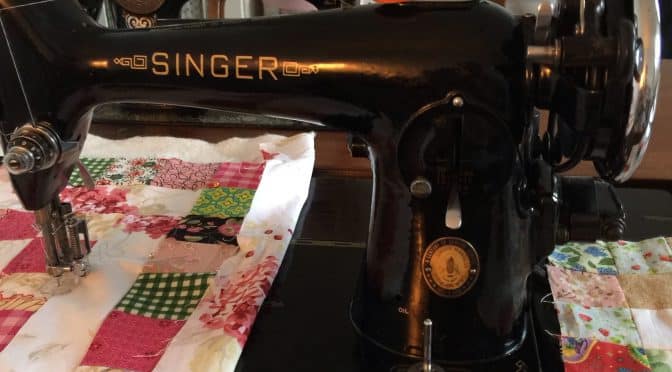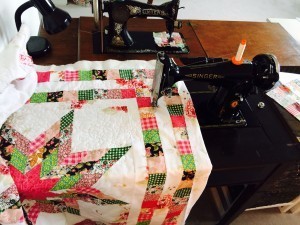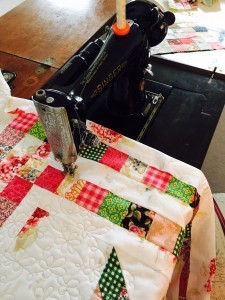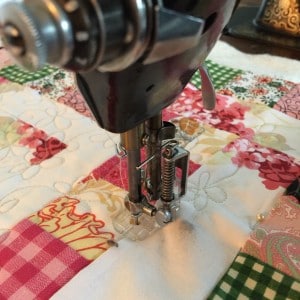Vintage Singer 201K and FMQ
The Vintage Singers are wonderful machines. Reading more about these machines is fascinating. During their heyday they were used to sew the upholstery for cars. I think that gives an indication of the strength and power of the machine. They were sometimes referred to as the “Rolls Royce” of sewing machines as they were used for said company I believe.
This is my 1948 201K Singer. At the time I found this machine, I have to confess, I didn’t really appreciate a lot about it.
I found it in a second hand shop. This machine is set into a small, rather simple but elegant Library Cabinet. It has an electric belt driven motor at the back. I asked the shop owner if it worked. I didn’t want to drag a heavy machine home if it didn’t work. It sounded good, so I took a chance on it for the cost of $60-
Once I got it home, I had a really good look at it. All the electrics looked very well preserved and the motor sounded great. I cleaned the machine and the cabinet well with a damp cloth removing all dust and spider webs. Then I polished the cabinet with boiled Linseed Oil to bring back the timber nicely. I then cleaned the machine again with sewing machine oil, and oiled the machine. I repeated the oiling for a few weeks.
The rubber belt for the hand wheel was perished and the light bulb was not working. I purchased a new rubber belt and bulb from my local sewing machine centre. I also purchased a clear foot for darning and quilting. I had to try a couple, one didn’t work and one did. I have since seen better feet, with nice open toes, but have yet to try them.
I added the new belt and bulb then worked out the threading and bobbin winding.
Once I worked those out I started sewing with it and I was so delighted with the results. I used it for piecing for a while. Then converted it permanently to my free motion quitting machine. It’s a very sturdy machine.
The LIbrary cabinet is important, as when it folds out, it literally creates a flat bed. The throat space is good too. As the timber is flat and slippery this enhances the space and ease of the free motion quilting experience.
If the machine gets a bit noisy I know it needs oiling. It also has a knee control which offers extra control and stability.
My set up for free motion quilting.
I tried dropping the feed dogs as I had read in various places that this was necessary for Free Motion Quilting (FMQ). This turned out to be a fallacy. I reengaged the feed dogs and had a better result. Make sure the machine is threaded correctly. Ensure the correct metal bobbin is used. Set stitch length to zero. Apply a clear or open toe darning/quilting/embroidery foot. It’s a low shank variety. Use a new quilting needle. I have tended to use a heavier needle, it seems to cope better. Use quality thread, matching top and bobbin. Please ensure (and this is important) that there is no tension on the upper thread. It really needs to flow off the spool without any tension or jerking. If possible get a thread spool holder with the extended antenna. Don the gardening gloves. Purchase an extra lamp if necessary to improve visibility.
Spend some time experimenting until favourable stitches are achieved. Each machine may perform a bit differently, so don’t give up. The setting I have given are a guide, you may need to make further adjustments.
The 201 K is a lovely machine to use for sewing and quilting. Apparently they are a bit more challenging to achieve FMQ on. Im glad I did not realise this before I purchased this machine. I was determined to make it work!
For more information See my series of posts on Free Motion Quilting.




